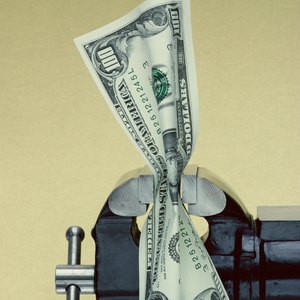
The process of living in society involves making and spending money to purchase goods and services. Over time, inflation reduces a dollar's buying power so that the same dollar buys you less from one year to the next year. By learning the fundamentals of inflation and how it works, you'll have a better idea of how a financial system operates.
Inflation Definition
Inflation involves the increase of product and service prices over a set period of time. Instead of tracking one commodity or service, the U.S. Federal Reserve tracks the overall price changes of items bought and sold in the economic system by using price indices. By examining price indices, the Federal Reserve can make predictions about future inflation rates to help manufacturers and consumers plan and prepare.
Purchasing Power
Purchasing power involves the connection between a dollar and the amount of or quality of the goods or services a consumer can purchase. As inflation constantly changes the value of a dollar, the purchasing power of the dollar goes up or down depending on whether inflation rises or falls.
Consumer Price Index
The price of average goods and services purchased by consumers changes from month to month. These tracked changes make up the Consumer Price Index. Another statistic, Personal Consumption Expenditures, tracks the adjustments made in response to the CPI. If the price of one item rises, spending choices often change as people choose less expensive items.
Inflation and Income
The average inflation rate in the U.S. has remained steady at 3 percent overall for roughly 100 years. Optimally, over time your income will exceed inflation to ensure that your earnings grow and expand.
Planning for the Future
Inflation has a negative impact on retirement planning when you realize that your purchasing power will be vastly different by the time you reach retirement age and are ready to spend your retirement savings. To ensure that your savings will have the necessary purchasing power, your savings will need to outpace inflation. The amount you save will need to increase by the same percentage of inflation every year to ensure purchasing power parity.
References
- Federal Reserve: What is Inflation and how does the Federal Reserve evaluate changes in the rate of inflation?
- Congressional Research Service. "Introduction to U.S. Economy: Inflation," Page 1. Accessed Sept. 17, 2020.
- BLS. "CPI Inflation Calculator." Accessed Sept. 17, 2020.
- BLS. "Consumer Price Index – July 2020," Page 4. Accessed Sept. 17, 2020.
- BLS. "Consumer Price Index – July 2019," Page 4. Accessed Sept. 17, 2020.
- FDIC. "An Update on Emerging Issues in Banking," Page 1. Accessed Sept. 17, 2020.
Writer Bio
Kathryn Hatter is a veteran home-school educator, as well as an accomplished gardener, quilter, crocheter, cook, decorator and digital graphics creator. As a regular contributor to Natural News, many of Hatter's Internet publications focus on natural health and parenting. Hatter has also had publication on home improvement websites such as Redbeacon.

